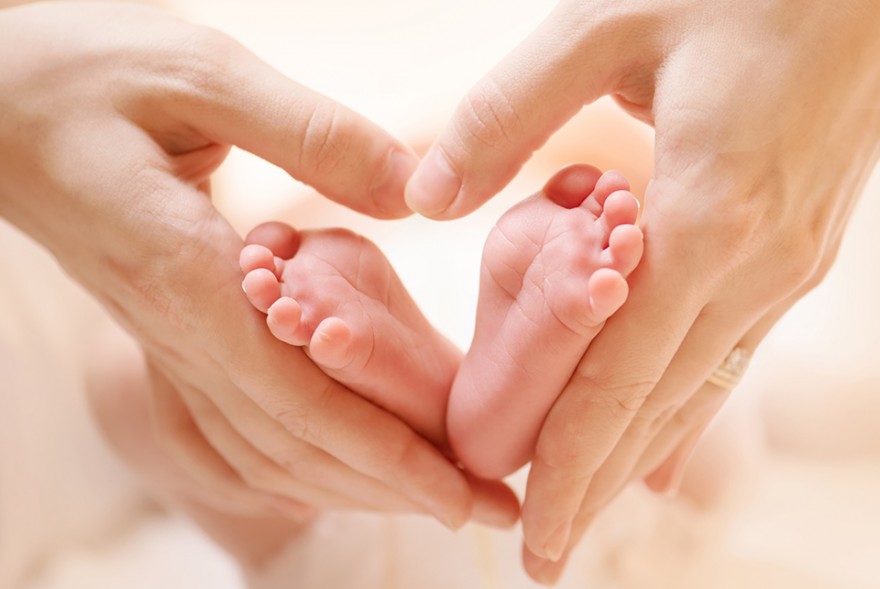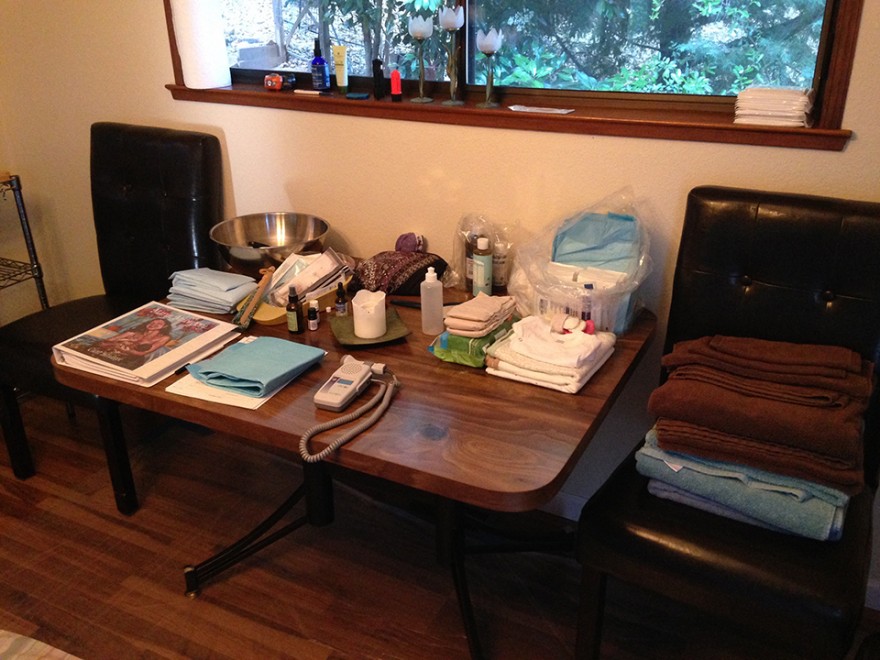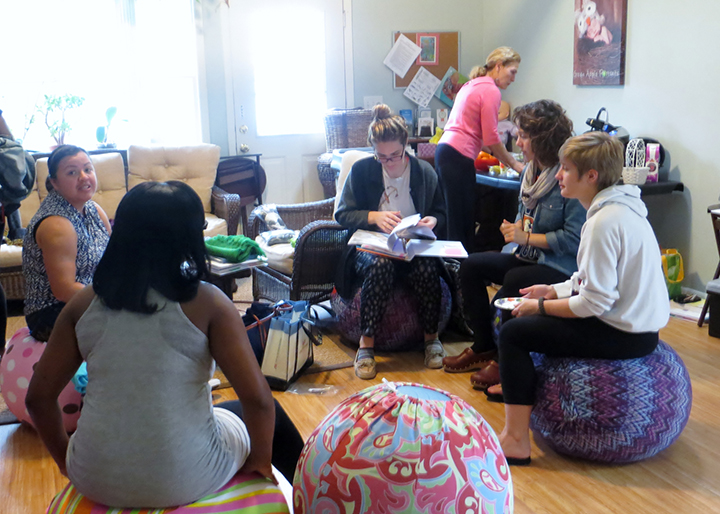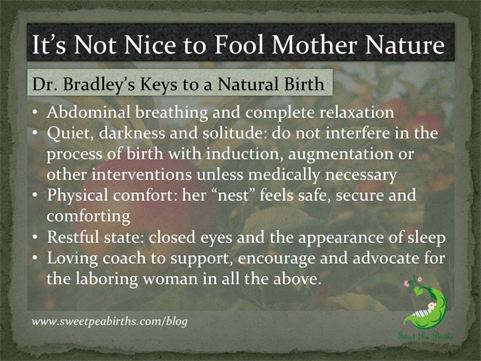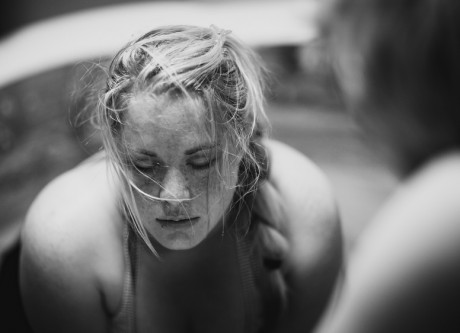-Beautiful Birth Story-
The birth of my first daughter at home was the most wonderful experience of my life to date. That day I experienced a full spectrum of emotion- from disbelief, fear, exasperation, frustration, relief, joy, gratitude and peace. And I was very lucky to find Annemarie and her team to help guide my husband and I through the scariest but most exciting and rewarding day of our lives.
Before I launch into the actual day of events, I want to give a little bit of background. A home birth was something that I did not decide from the outset – I am by nature an anxious person and very skeptical, which is probably why my husband and I waited until after I was 7 months pregnant to decide to do a home birth. It was something I was interested in, but after 2 miscarriages, having to take a daily regime of baby aspirin, and having a low lying placenta at 18 weeks, I believed that there was something “wrong” with me and that my pregnancy would require a full medical team because “something” was going to go wrong and require an intervention. I figured that it would be just my luck, since nothing ever goes according to my most well-laid out plans! The fact that in my family we had a history of “difficult” births (emergency c-sections, maternal death, etc.) only reinforced this belief. (Did I mention that when I was young I didn’t want children because of the fear of childbirth and related pain? Yes- that was me!) But, as I got closer to my due date, I began to very much doubt the care I would receive from my OBGYN and her ability to listen to what I wanted, notwithstanding her stellar credentials. My appointments with her lasted about 10 minutes and she was regularly dismissive of my inquiries on the process and what I wanted (my husband witnessed this and became very infuriated of how dismissive she was to me). My list of grievances grew as my pregnancy wore on and I contemplated having a home birth instead given the wonderful stories I had heard, but I was admittedly still nervous. When I was about 30 weeks along, I had a second fetal scan which showed that my placenta had moved up. The specialist declared I had a normal pregnancy and they didn’t need to see me again. This was my green light to go with my gut and go with a home birth. Having previously interviewed midwives in contemplation of my placenta moving up and deciding I wanted Annemarie, I contacted her immediately to tell her the good news.
Annemarie reminds me of an old friend you have known forever. For me, her most important qualities as a midwife, aside from her technical expertise, are (a) she is always calm and (b) she is non-judgmental. The women I spoke to who used Annemarie’s midwifery services for their home births had nothing but wonderful things to say about her. After hearing their stories I was excited for my own birth! Annemarie spent so much time getting to know me, my husband and even our dog during our appointments. Her apprentice, Dani, was equally attentive. I felt listened and unrushed. It made me feel comfortable and reassured, even as I was nervous for the big day. (I also asked her a ton of “what-if” worst case scenario questions which she readily and expertly answered, I might add).
OUR BIG DAY! On the Wednesday evening before my baby’s due date, I started to “feel” something. I assumed they were contractions – squeezes around my baby-belly – and a few times they were a bit uncomfortable when I was standing. I assumed things might be starting but wasn’t really sure. I went to bed and woke up Thursday morning, nothing much had changed although I lost my mucus plug and had my bloody show around 8:45 a.m. I was still having these “squeezes”, which were uncomfortable at times but didn’t stop me from going about my day and getting things checked off my to-do list. (I blissfully thought “Hey, this labor thing is easy – must have been all that red raspberry leaf tea I drank!“). I finished the tasks off my to-do list, had some spicy Thai food for dinner (to help speed up the process) and a tiny glass of red wine (to relax) before going to soak in the bath tub. I went to bed around 10pm. At 2:22 a.m. Friday morning, I woke up and realized I was having “real” contractions! I woke my husband up (yes, a good wife would have let him sleep) and had him get me an English muffin with peanut butter (the last solid food I ate before she was born). He also brought in the yoga mat, exercise ball, wedge pillow, etc. for me in my attempts to get comfortable and try my hypno-birthing breathing. In the end, I crawled back into bed and slept as much as I could. After 6 a.m., I couldn’t sleep anymore so I just focused on breathing and timing my contractions. By around 8 a.m., my husband had contacted Annemarie and by around 10:30 a.m. Annemarie and Dani arrived. They came in and checked on me (I was still in bed, breathing through my contractions and timing them) before going to set up. By 11 a.m., the contractions were so intense that I could no longer just “breathe” through them. The intensity was no longer just under the baby part of my belly but had traveled all the way around my back and was now like a belt. I wanted to yell and cry out in pain. But, I really didn’t want to do that because (a) that would tired me out pretty quickly and (b) let’s be honest, I didn’t want all my neighbors hearing me and calling the police (I would have been self-conscious about that aspect even in the hospital!). So, I vocalized the exhale of my breaths (my husband called it “chanting” although there was nothing mystical or musical about it – more guttural than anything!). Annemarie then came in and asked if I wanted to get into my bathtub (we have a deep bathtub and it would be easy to keep clean and refreshed with warm water while I was in the early stages of labor rather than getting in the deeper birthing tub at the outset). We got me into the tub and it helped with the intensity of the contractions, although the intensity was still building. Annemarie and Dani took turns holding my hand through the contractions and even “chanted” with me, especially as the contractions got more intense causing me to lose my breath. They made sure I stayed hydrated and nourished with water, protein Odwallas, coconut water and vitamin water, and they also kept my head cool with lavender scented washcloths. It seemed like every hour (maybe more or less – I couldn’t tell) Annemarie would ask to check the baby’s heart rate with the monitor to make sure she was okay.
A couple things were going through my mind during my active labor phase – (a) I was SCARED, which as soon as I said those words out loud during labor (multiple times, I might add), Annemarie and Dani reassured me all was well and then I felt less so (FYI – it was the most helpful thing for me to know going into this process that most women in labor get scared and it is not a sign of failure or trouble), (b) I was so tired all I wanted to do was take a nap – I actually dozed off in between contractions!?!, and (c) I was fretting that I wasn’t doing my hypnobirthing meditations (I didn’t even want to hear the relaxing music mix my husband and I put together for the big day!!), but Annemarie assured me I was doing great. I just kept breathing and vocalizing/”chanting” and tried to envision each contraction like the undulating waves in the ocean- after the intensity peaked, it would bring me back down. I remember Annemarie asking me if I wanted my husband with me, to which I replied “no” (Really, what could he do? Just worry about me and his helplessness in this situation? That would have been too stressful for me). Annemarie also asked him the same question and he also declined (smart man). I just wanted either Annemarie or Dani there holding my hand and “chanting” with me.
At some point, Annemarie mentioned that she was concerned that I hadn’t urinated but I have had a ton of fluid to stay hydrated. My body couldn’t go on its own in the tub so she suggested I get on the toilet to try. I didn’t have much success – some but not much. BUT, getting out of the tub up’ed in intensity of my contractions and lessened the time in between them. I had a few of these rockstar contractions before I could crawl back into the tub. Annemarie or Dani tried pushing down on my hips to help lessen the intensity, but I just remember thinking I needed to get back into the tub. I had not realized previously how much the water helped labor! A while later, after I had been asking Annemarie what the next stage would be like (because what I really wanted to know was “HOW MUCH LONGER!?!? I want to take a nap!“), she asked me if I wanted her to check to see how dilated I was. Although I was loathe to leave the tub, I was anxious to know how far along I was (aka “When can I get my nap?“). We made our way into the bedroom and on the bed, and she declared I was 7 cm dilated but that during a contraction I dilated to 8 cm – these numbers meant nothing to me but she assured me things were moving along very well. I got back into my beloved tub, continued my chants and envisioned that nap I would soon be getting.
After a while, the contractions were so intense they actually caused me to lurch forward from my reclining position in the tub. I asked Annemarie (again) what the next stage would be like, she told me I would feel the urge to push. (Score!!) I was in the next stage! (Nap time here I come!!) I informed her in between chants that I was there and wanted to push, and she told me to go ahead. So I started pushing. My husband had periodically come to check on me (but stayed out of sight) and had returned soon after I started pushing. He was there when my water broke at about 4:15 p.m.- we all heard a loud pop in the water. I had no idea what had happened (Did I have my baby?!). Annemarie declared my bag of waters had opened and everything looked good. (Whew and hooray- next stage!!) So with each contraction I am now pushing. Annemarie suggested that I might want to get in a squat position to let gravity help me bring the baby out. It was awkward to do in my regular tub, especially given how tired I was and because now I am also vomiting all the fluids I dutifully took in earlier, so Annemarie suggested I try the birthing stool. I got on the birthing stool and my husband sat in front of me to hold my arms/hands and give me support but he actually ended up holding the bowl (previously used to hold those wonderful lavender scented washcloths) to catch the contents of my stomach (What can I say, I was taking this pushing work seriously!). He and I joked during my pushing that the last time he helped me in such a compromised position was probably 9 years ago when he held my hair while I was sick at a nightclub – but that’s another story…
Our baby was having a difficult time getting through my pubic bone and Annemarie had suggested emptying my bladder with a catheter to give her head more room. The first time she suggested this, I didn’t take her up on her offer. It sounded very uncomfortable and the idea made me squeamish (although apparently having a baby didn’t – go figure…). I was sure I could just push through this (pardon the pun) and get the baby out without it. After a bit more pushing without much success, Annemarie suggested the idea again and this time I took Annemarie up on her offer. I was eager to get my baby out and see her (I had forgotten all about the nap now). We all moved into the bedroom, I got on the bed, and as Annemarie cleaned the area in preparation for inserting the catheter, my bladder released enough on its own so that it was no longer necessary (WHEW!!!). So, I went back to pushing. Someone held my legs in an assisted squat and someone massaged my downstairs parts with a warm compress and olive oil to prevent tearing. Soon, Annemarie asked if I wanted to reach down and feel my baby’s head, which prior to actually being in labor I thought I would definitely want to do. However, when push came to shove (I love these puns!) I did not want to break my focus – I wanted my baby out!! At 5:46 p.m., her head was out! A minute and half later the rest of her came out and my husband caught her! She made one little yelp and that was it. They placed her on my stomach with receiving blankets on top of her and I remember looking down my chest and trying to see her. Her little eyes were taking everything in. She didn’t make a sound but I could see her blinking every so often. I wanted to pick her up right away and examine her, but we were still attached. Annemarie instructed me to push again and I remember my inside voice saying, “Um, I’m done pushing. Did you see that baby come out? There is nothing left to push! I can’t feel anything!” But, she was right and about 15 minutes later with a few more pushes my placenta was out. My husband then cut the cord that had connected me to my baby for 40 weeks to the day. Yes, she was born on her due date as the sun was setting so it was a dim and quiet room! She had the quiet entrance into the world that we had hoped for and I did it! I felt like I could climb Mount Everest that moment! When I got to hold my baby for the first time it was the best, most rewarding feeling I have ever had. I was so full of love and awe for her and what we had just accomplished. After they weighed and measured her, we learned she was 8.0 lbs and 20 inches long – I couldn’t believe it!
Annemarie and Dani cleaned up lickety-split – no one would have known that I had just delivered my baby there that evening. Even the towels and sheets were cleaned! My husband and I then enjoyed a quiet dinner in bed together. (Leah, the midwife for my baby had already inspected the baby to make sure she was ok and Annemarie had inspected my lady parts to make sure I didn’t have any tears, which I didn’t! Yay!). It was wonderful to sleep in my own bed that night!
My labor was challenging and scary at times but I had excellent support to guide me through the journey. Annemarie and Dani were calm throughout and that helped me stay calm and focused. They were also very supportive and always asked me before anything was done. Annemarie’s checkups after our baby’s birth were wonderful, especially since we don’t have family out here and the majority of our friends do not have children. She provided holistic care in every way and I truly felt supported and respected in the best way for me and my family throughout this life changing event. I feel truly blessed as I couldn’t have asked for a better experience and it was all thanks to Annemarie and her team of wonderful midwives.





